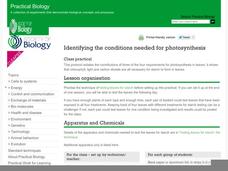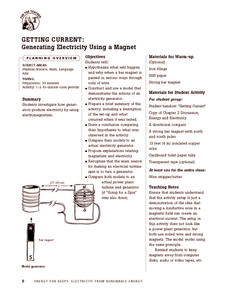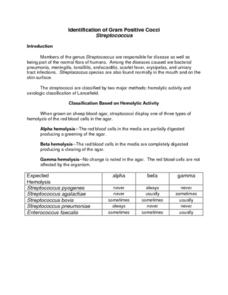DiscoverE
Marble Run
It's time to slow your roll! Can your class create a track that allows a marble to roll as slowly as possible? Teams of science scholars collaborate to design, build, and test their tubes while learning about gravity and friction.
Texas State Energy Conservation Office
Investigation: Building a Parabolic-Trough Collector
Amateurs of alternative energy build a mini parabolic-trough solar energy collector and use it to heat water. Temperature is recorded over a three-minute period and the data is graphed and analyzed. Note that in order to paint aquarium...
Teach Engineering
Exploring Capillary Action
Explore capillary action from different perspectives. In the fourth installment of a nine-part series, scholars perform several experiments to observe capillary action. They look at the meniscus of water in a glass, observe capillary...
Curated OER
Roller Coasters
Twisting and turning through the sky, roller coasters are popular attractions at amusement parks around the world, but how exactly do they work? Explore the physics behind these thrilling rides with an engineering design activity....
Nuffield Foundation
Identifying the Conditions Needed for Photosynthesis
Budding biologists often ask how scientists know what they do about different topics. In the lab described here, they have a chance to find out first-hand about the requirements for photosynthesis. Three sequential investigations are...
Teach Engineering
Amusement Park Ride: The Ups and Downs in Design
Groups design the ultimate roller coaster by considering potential and kinetic energy. They test their designs using marbles and then go on to rate each group's design based on aesthetics, loop diameter, and cost.
Curated OER
Acrylic Painting Quiz
After setting the ground rules, test the class on what they recall about using acrylic paint in class. This quiz is intended to ensure that every young artist is willing to use the class art supplies in a careful and conscientious way....
Nuffield Foundation
How Much Energy Is There in Food?
People associate calories with food, but what is a calorie? Young scientists measure the number of calories in samples of food to better understand the concept. They test a variety of samples, take measurements, and compare their results...
Scholastic
Study Jams! The Respiratory System
Inhale, exhale, and rest easy when looking for a supportive tool for your activity on the respiratory system. Seven slides introduce the class to the function of the organs: lungs trachea, diaphragm, bronchial tubes, bronchioles, and...
DiscoverE
Tape Dispenser Challenge
Help your class get out of a sticky situation! Future engineers explore existing tape dispensers and then design a new system for dispensing tape. To put these systems to the test, they build and evaluate prototypes of their designs.
Energy for Keeps
Getting Current: Generating Electricity Using a Magnet
Give your class a magnetic charge with this creative experiment designed to teach emerging scientists about electromagnetism. Pupils construct a model that demonstrates the function of an electrical generator and test this creation in a...
Curated OER
Chromatography
Advanced techniques for the lab use of chromatography are detailed here and your students will learn the specifics of separating molecules using a staionary and mobile medium. Diagrams of the equipment used and some facts about how...
DiscoverE
Conveyor Belt
Convey your interest in conveyor belts. By considering different size tubes, groups create a conveyor belt that can transport boxes of candy at least four feet. Also, the conveyor belt must make a 90-degree turn—quite a difficult task!
DiscoverE
A Leg to Stand On
Give your learners a leg up in their study of engineering. Groups design and create a prothestic for a leg. They test out their designs for strength, stability, durability, and comfort.
Cornell University
Building Spectroscope
Given specific materials, scholars follow a set of instructions to build and calibrate their very own spectroscopes. After construction, they test the scope for accuracy and make modifications where necessary.
Curated OER
What is Dissolved Oxygen?
Young scholars experiment with the LaMotte Winkler-Titration Test Kit to try to answer the question of what is dissolved oxygen. They explore all the possible ways to test for dissolved oxygen and brainstorm all the obstacles that can...
Curated OER
Science Safety Rules
In this chemistry worksheet, students read the paragraphs on the sheet to locate the broken safety rules. Then they underline each one of these and count how many they found.
Curated OER
Lung Capacity
In this lung capacity worksheet, students use straws, funneling, liquids, tubing, and more to test their lung capacity. Students follow 14 sets of directions and analyze their data.
Curated OER
Sonic Speed
In this sound speed learning exercise, students use paper towel tubes and rulers in partners to test where sound comes from. Students follow 5 sets of directions, answer 1 question, and fill in a chart.
Curated OER
Viruses And Variables
Students explore viruses and how your body fights against them. In this viruses and variables lesson students complete an activity with test tubes and try different variables to see what changes.
Curated OER
Talking Tubes
Students study the theory that sound travels through a variety of instruments. They explore all the channels of the ear and its various purposes. Students test objects to see which ones were vibrating to make sound heard.
Curated OER
Identification of Positive Streptococci
After being introduced to the genus Straptococcus, biology buffs set up agar plates, esculin slants, and salt broth tubes with different species to test. The level of laboratory skills required to perform this activity makes it most...
Curated OER
Am I Neutral? pH Properties in Soil
Students participate in a science lab to determine the pH of three different soil samples. Students conduct an experiment by creating a question, a hypothesis and then an investigation of soil samples. Then they compare colors apprearing...
Curated OER
Swinging Electrons
Students illustrate paramagnetic and diamagnetic differences due to the unfilled and filled valence shells. They prepare saturated solutions and place into test tubes.
Other popular searches
- Test Tube Babies
- Test Tube Sex
- Pod Test and Tuberculosis
- Pd Test and Tuberculosis
- Ppd Test and Tuberculosis
- Test Tube Science























